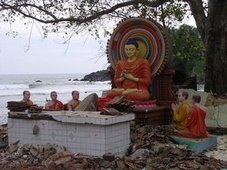


Riolta Lanka Holidays (Pvt.) Ltd., Sri Lanka
We reveal for you to revel : the right stuff
We reveal for you to revel: our Island, our Nation & our Faith will Prevail
Manadil Urdi Vendum
B. U. N. Peiris www.bunpeiris.com
www.mysrilankaholidays.com www.rioltalankholidays.com
Sri Lanka, The Land of Delights
Sri Lanka is the ideal location for an Asian IT HUB. But then where are the Sri Lankan experts? Idling in an Ideal location?
Internet for Economic DevelopmentUSAID/W and USAID/Sri Lanka are convinced that Sri Lanka is well situated for pursuing Internet applications for development.1 For that reason, a team sent from USAID/W joined with USAID/Sri Lanka staff to undertake an assessment and present ideas for including Internet-related projects within USAID/Sri Lanka
activities, with particular focus on providing value-added ideas for integration with the existing focus on competitiveness and the Mission’s support of the Technology Initiative for the Private Sector (TIPS) program.
The U. S. program in Sri Lanka supports the following U.S. foreign policy and strategic goals: broad-based economic growth and agricultural development, democracy and good governance, and humanitarian assistance. Within South Asia, Sri Lanka provides a unique environment for advancing these interests. With the Government of Sri Lanka (GSL) focusing on ending the ongoing ethnic conflict, and with clear potential for achieving sustainable economic growth, USAID is helping the country move through an important political and economic transition.Sri Lanka has a fifty-year tradition of vigorous democracy with competing political parties, a free press and an independent judiciary. Although it has achieved high levels of literacy, low birthrate, low infant mortality rates and broad gender equality and has made progress on economic reforms, it remains at the bottom of the list of middle-income developing countries. The prolonged 15-year ethnic conflict raging in the North and East Provinces continues to threaten its progress.
The Sri Lanka economy remained resilient in 1998 despite adverse external conditions in the region and increases in defense expenditures. A growth rate of 5% is expected for 1998, which is below the initial target of 6%. Growth in the economy remained highly dependent on export earnings from the garment sector and from plantation crops. Although Sri Lanka has made progress in macro-economic reforms, progress on financial and structural reforms that would stimulate productive investment, diversify the economy and raise incomes has remained slow.
USAID's programs are aimed at improving the trade and investment environment. Building on previously developed strong relationships with a wide range of companies, USAID's programs strengthen business associations that promote key reforms related to agriculture, manufacture and trade liberalization, and that improve business strategies for global competitiveness.
An open and transparent financial market, which shifts from being dominated by banking to strong capital markets, is essential for Sri Lanka to improve its competitiveness. USAID has had considerable success in establishing a modern and efficient stock exchange in Sri Lanka, but the stock market remains small in capitalization. USAID programs support expansion of the investor base and contribute to improving regulation and increasing transparency of the capital market. USAID programs also support establishment of new financial instruments, including development of corporate bonds to facilitate financing of industry and infrastructure development.
Despite the war, Sri Lanka’s economic performance has been relatively satisfactory. Its rate of growth places it in the top 20% of countries worldwide in terms of real GDP growth during the period 1995-97. Much of this growth has been led by exports, especially textiles and garments, which have more than tripled in real terms over the last decade. However, recent global trends in the garment and textile sectors suggest that continued growth will depend on development of other sectors within the economy. As a result, USAID/Sri Lanka undertook a competitiveness assessment in the summer of 1998, which resulted in a number of important findings, including:
- Although there is still room for improvement, the Sri Lankan government scores fairly well relative to other countries on its macroeconomic framework;
- The government also has performed relatively well in the active and creative use of fiscal policy to mobilize investment and boost exports. However, continuing to rely on incentives is not a sustainable source of a competitive advantage for Sri Lanka, largely because other countries can replicate the strategy and it fosters complacency in the private sector;
- In stark contrast to the strength of the reform of macroeconomic policies, the policy, legal and regulatory framework facing individual firms in the private sector is deficient;
- Weak business strategies and a lack of understanding of competitive position characterizes much of Sri Lankan industry, including tourism, toys, gems and jewelry, and floriculture; and
- While the war is a factor in discouraging economic development, any prospective “peace dividend” will be disappointing if the enabling environment for business is not improved.
The assessment concluded that “whether Sri Lanka will progress rapidly to develop a fast-growing, outward-looking economy depends fundamentally on reaching a national consensus on a competitive strategy, making the necessary policy and regulatory reforms that will improve the enabling environment for firms, and on the firms themselves, implementing better business strategies.”
The evidence suggests that the implementation of information technology strategies can effectively fuel economic development and competitiveness in Sri Lanka. This assessment report provides a roadmap for such implementation.
The assessment team wishes to thank the following people for their assistance in completing the assessment while in Sri Lanka: Lisa Chiles, Gary Robbins and Sarasali Fonseka in the USAID/Sri Lanka Mission; Ray Jubitz and Sujeewa De Alwis of TIPS; Lalith Gamage of CyberTrader; and Jayantha Fernando of CINTEC.
March 2000
That was in March 2000. Its 2008 now & what have achieved since then? Where are we in IT today?







































1 comment:
That was March 2000!
Good question. Where is Sri Lanka today on this front?
Post a Comment